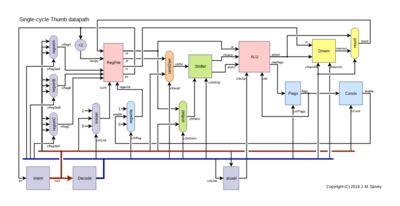Lecture notes: Difference between revisions
| Line 50: | Line 50: | ||
==Trinity Term== | ==Trinity Term== | ||
{{ContextBox|Note|Owing to disruption in the last part of Hilary Term and the whole of Trinity Term, the remainder of the course in 2019--20 was replaced by a [[Condensed course (Bat Flu edition)|condensed version]] supported by online video recordings.}} | |||
[[Image:Stage9.png|thumb|400px|right|A Thumb datapath|link={{filepath:Datapath.pdf}}]] | [[Image:Stage9.png|thumb|400px|right|A Thumb datapath|link={{filepath:Datapath.pdf}}]] | ||
Revision as of 10:29, 25 March 2020
Each lecture title is a link to notes for that lecture. The notes for some lectures have a section at the end for questions asked during or after that lecture by the audience this year or in previous years.
Hilary Term
Assembly-language programming
The first few lectures will be about programming a microprocessor in assembly language, including the detail of how each kind of instruction operates.
[1] Microcontrollers and embedded programming. Architecture of the micro:bit. Programmer's model. Execution of an instruction.
[2] Building a program. Compiling and building a program.
[3] Multiplying numbers. Conditional and unconditional branches. Instruction encodings. Execution time.
(Handout)
[4] Number representations. Signed and unsigned numbers. Numeric comparisons.
(Handout)
[5] Loops and subroutines. A better multiplication algorithm. Stack frames. Recursive calculation of binomial coefficients.
(Handout for this lecture and the next)
[6] Memory and addressing. Addressing modes. Arrays. Example: Catalan numbers.
[7] Buffer overrun attacks. A hacker's guide.
(Handout)
- A set of slides used in the lectures, put here as a convenient way to make them available for displaying – and updated when necessary. (All contain the same information as in the notes.)
Input and output
The next lectures are about different kinds of I/O interaction, including interrupts.
[8] Introducing I/O. Memory-mapped I/O. GPIO. Multiplexed LED display.
(Handout for this lecture and the next)
[9] Serial I/O. Serial protocol. A simple, polling UART driver.
[10] Programming with interrupts. Interrupt-based driver for UART.
(Handout for this lecture and the next)
[11] The interrupt mechanism. What the hardware does with interrupts.
Embedded operating systems
The last part of Hilary Term has lectures about using and then implementing a simple process scheduler, allowing asynchronous events to be handled in a manageable way.
[12] Introducing Phōs. Processes and messages.
[13] Device drivers. Server processes. Interrupts as messages from the hardware.
[14] Context switching. Implementing interleaving of processes by saving and restoring context.
[15] Implementing processes and messages. Process table. Ready queue. Send and receive.
[16] We're going on a bug hunt!. Exploring the operating system by fixing a bug.
Trinity Term
Note
Owing to disruption in the last part of Hilary Term and the whole of Trinity Term, the remainder of the course in 2019–20 was replaced by a condensed version supported by online video recordings.
Hardware elements
In the first part of Trinity Term, the lectures are about constructing logic gates from transistors, and then building those logic gates into modules we can later use to design a computer. Helpful reading for this part of the course is the appendix on Basics of Logic Design from the recommended book by Patterson and Hennessy.
[17] Introduction. Plan for the term. Combinational logic.
[18] Transistors and logic gates. Building gates from transistors. CMOS logic.
[19] Sequential logic. Flip-flops. Designing sequential circuits.
[20] Architectural elements. Circuits for arithmetic. Multiplexers. Register files. Arithmetic-Logic Unit. Barrel shifter.
Microprocessor architecture
The second part of Trinity Term has lectures about using architectural modules to build a simplified implementation of the Thumb instruction set.
[21] Designing a datapath.
[22] Continuation.
[23] Phōs device drivers – a sample exam question.
[24] Three instructions. Using the datapath to implement three typical instructions.
